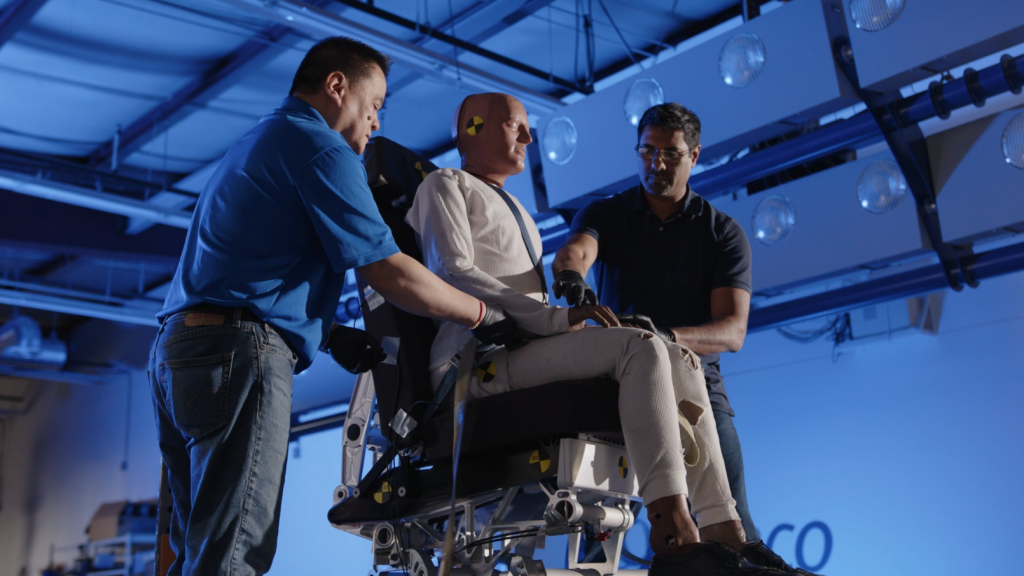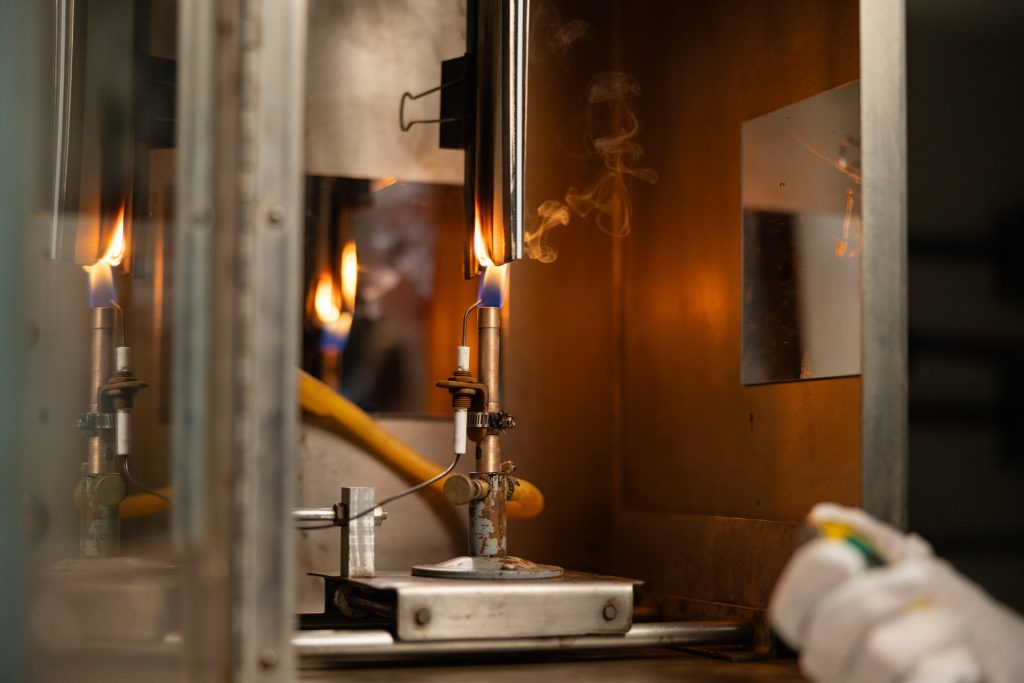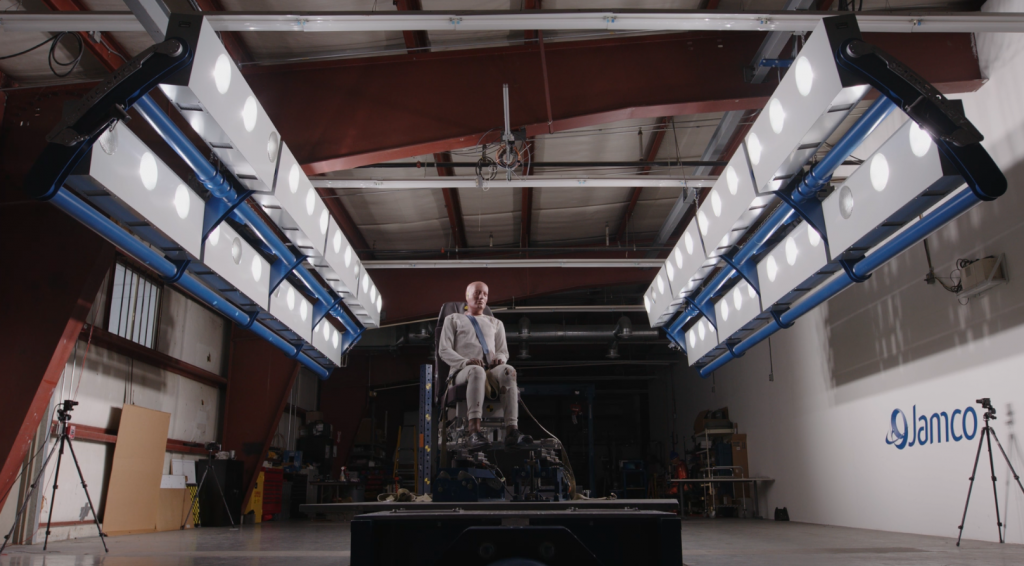By Jennifer Ferrero
Jamco America of Everett, Washington, offers a facility for ballistic, static, flammability, and dynamic testing to regional manufacturers, certifying the safety of aircraft parts.
Commercial aircraft are often in service for longer than any other type of vehicle, typically spanning over three decades. The longevity or lifespan of the aircraft requires high-quality testing of aircraft parts, such as seating, doors, cabinets, and other components, to ensure they are secure and functional. With 45,000 daily flights handled by the FAA and 10 million scheduled passenger flights annually, the safety of the thousands of parts on a plane is non-negotiable. Jamco America, Inc. of Everett, Washington, offers commercial aircraft testing services for both high-end seats and products manufactured by the company, as well as aerospace parts testing for other manufacturers.

The testing lab offers dynamic and static load testing, life cycle testing, intrusion-resistance testing, fire properties testing, and fire containment testing. Executive VP of Jamco America, Inc., Donald Wren said, “With a constantly growing demand for commercial aircraft interior products and services, we help aircraft manufacturers, operators, and other suppliers by providing high-quality testing services in our FAA-approved facilities.”
He noted most people within the regional aerospace industry are aware of their fire properties test facility, but don’t know they have a dynamic test facility for aircraft seating. He said they have a dynamic sled installed by Seattle Safety, complete with crash test dummies, to ensure that during a crash, the aircraft seats are firmly adhered to the aircraft at 16Gs.
Wren stated that before 1994, a series of aircraft accidents occurred in which the plane overran the runway during an emergency landing. He cited the survivability of these accidents, but said the seats broke free, which caused people to become crushed by the weight or have broken limbs. In some cases, the passengers died from smoke inhalation when trapped on the aircraft.
The FAA implemented a rule requiring seat designs to include a mechanism that prevents dislodgment, allowing passengers to escape the aircraft within 90 seconds. Jamco implemented dynamic testing in 2016 and obtained FAA approval in 2017. Currently, they test aircraft interior components, including seats, seat furniture, lavatories, closets, class dividers, partitions, flight deck doors, and more.

Wren noted, “The Part 25 Airworthiness Requirements (FAA & EASA) for cabin safety are all designed to work in unison to help you survive emergency landing situations.” He said the 90-second evacuation is essential because the aircraft can quickly reach flashover point due to the flammability of jet fuel. “There are cabin safety system regulations for FAA and EASA for structural, flammability, aisle widths, seat installation distances, signage for exits, etc.” All regulations are meant to operate in unison.
“It is likely the airplane will catch on fire due to the fuel.” According to regulations, all materials must be self-extinguished upon exit from the plane.
“As an integral part of Jamco America’s business operations, the mission of our test facilities is to demonstrate industry-leading integrity as we deliver innovative and sustainable solutions for our customers,” said Wren.
Corey Nianekeo is the supervisor of test services for Jamco. He said, “Our bread and butter is in aircraft modifications — where we gut an airplane and upgrade it to newer furniture, stow bins, bar units, seats, lavatories, and galleys.” However, they also perform significant work in premium, first-class, and business-class seating, which they’ve done over the past eight years.
Seattle Safety’s Director of Sales and Marketing, Matt Sikora, stated that they began providing testing for Jamco in 2010, testing at their facility in Auburn, Washington. He said that around 2015/2016, Jamco purchased the testing equipment from Seattle Safety, which was then relocated to Jamco’s site. Now, Seattle Safety is a manufacturer of the test equipment, but they no longer perform testing services. Sikora said they also provide the equipment for other businesses to conduct testing as Jamco does. He added, “Jamco has built up a nice testing lab with good equipment, all current.”
Nianekeo has a background in materials science and engineering and worked for a time in the marine industry. He has been with the company for 16 years and said, “We do a lot of testing.” They do static testing well and extend their services to external customers who need static testing. “Recently, we’ve taken on dynamic testing,” which they’ve done in-house since 2016, but now offer to external customers as well.
Wren said they have a testing facility separate from the Jamco production facility. He said this should assuage any concerns competitors may have about bringing their IP to the Jamco facility. Both Wren and Nianekeo said they sign all non-disclosure agreements with any customer bringing testing to their facility.
The 16G dynamic testing ensures that if an aircraft crashes to the ground, with 16 times the acceleration due to gravity, the permanent fixtures in the aircraft will not detach. If other suppliers make parts that the FAA requires to pass dynamic testing at 16G, they can validate the parts at Jamco’s testing lab.
Jamco supplies both Airbus and Boeing, as well as commercial airlines. The commercial airlines hire Jamco to conduct testing on their products. The testing services date back to 1982, when Jamco America established them. The longest tenured client relationship is with Boeing, according to Nianekeo.
The newest technology is dynamic testing, and Jamco plans to add an onboard camera. “It is more compact and stores more online memory. It would be on the sled and would record video. It will be mounted in a location where normal-sized cameras cannot be installed. Also, we have stickers that are placed on the parts of the anthropomorphic “test dummy,” and this would allow for more metrics that they wouldn’t be able to normally test on the sled.”
Nianekeo said they once had a customer who was working with a third-party for engineering work, and they needed measurements on Jamco’s seat reference point. “We dropped what we were doing and mounted it that day to get the data needed. It was something we could do on the fly,” he commented.
Wren shared that they also provide intrusion resistance and ballistic testing for the cockpit, which was implemented following the 9/11 attacks. Jamco has test requirements for 9mm and .44 caliber handguns, as well as testing for an object being rammed into the door. Fire containment testing includes tests for waste receptacles in the lavatory, in the case of someone putting a lit cigarette into the receptacle, “which they aren’t supposed to do,” Wren added.
Testing is mission-critical for all aircraft, and Wren observed, “With a constantly-growing demand for commercial aircraft interior products and services, we help aircraft manufacturers, operators, and other suppliers by providing high-quality testing services in our FAA-approved facilities. With our FAA ODA, we can also provide test plan/report approvals, test witnessing, and test article conformity inspections.”
Wren shared a customer story about installing an inverse herringbone-style seating in business class. “With this installation, there was a concern from the FAA that the seatbelt-mounted inflatable airbags could become a tripping hazard (post-deployment) as well as block the emergency proximity lighting along the main aisle. To address this concern, we worked with the seat supplier to develop and perform naïve subject testing to successfully demonstrate that the deployed air bags did not present a tripping hazard or block the emergency lighting. This successful testing helped support many follow-on installations of similar seating products.”
Overall, since many suppliers lack this in-house functionality, it appears that Jamco’s testing facility offers a solution to both OEMs and competitors, ensuring a higher rate of passenger safety in the event of a crash and preventing the plane from becoming a trap for passengers in the case of a fire. “Together with our customers, Jamco works to design and manufacture the highest quality, integrated cabin solutions that deliver passenger safety and comfort.”




